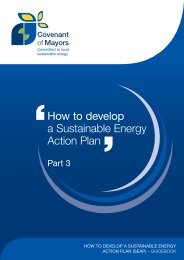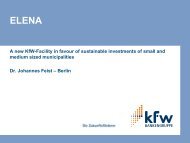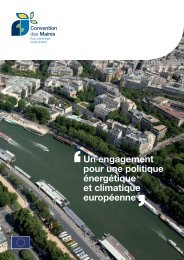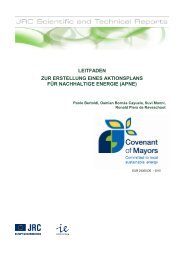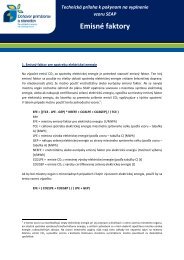English - Covenant of Mayors
English - Covenant of Mayors
English - Covenant of Mayors
You also want an ePaper? Increase the reach of your titles
YUMPU automatically turns print PDFs into web optimized ePapers that Google loves.
3. Emission factors<br />
3.1 Choice <strong>of</strong> emission factors:<br />
standard (IPCC) or LCA<br />
Two different approaches may be followed when selecting<br />
the emission factors:<br />
1. Using ‘Standard’ emission factors in line with the<br />
IPCC principles, which cover all the CO 2<br />
emissions that<br />
occur due to energy consumption within the territory<br />
<strong>of</strong> the local authority, either directly due to fuel<br />
combustion within the local authority or indirectly via<br />
fuel combustion associated with electricity and heat/<br />
cold usage within their area. The standard emission<br />
factors are based on the carbon content <strong>of</strong> each fuel,<br />
like in national greenhouse gas inventories in the<br />
context <strong>of</strong> the UNFCCC and the Kyoto protocol. In this<br />
approach, CO 2<br />
is the most important greenhouse gas,<br />
and the emissions <strong>of</strong> CH4 and N 2<br />
O do not need to be<br />
calculated. Furthermore, the CO 2<br />
emissions from the<br />
sustainable use <strong>of</strong> biomass/bi<strong>of</strong>uels, as well as<br />
emissions <strong>of</strong> certified green electricity, are considered<br />
to be zero. The standard emission factors given in these<br />
guidelines are based on the IPCC 2006 Guidelines<br />
(IPCC, 2006). However, the local authority may decide<br />
to use also other emission factors that are in line with<br />
the IPCC definitions.<br />
2. Using LCA (Life Cycle Assessment) emission<br />
factors, which take into consideration the overall life<br />
cycle <strong>of</strong> the energy carrier. This approach includes not<br />
only the emissions <strong>of</strong> the final combustion, but also all<br />
emissions <strong>of</strong> the supply chain. It includes emissions<br />
from exploitation, transport and processing (e.g.<br />
refinery) steps in addition to the final combustion. This<br />
hence includes also emissions that take place outside<br />
the location where the fuel is used. In this approach,<br />
the GHG emissions from the use <strong>of</strong> biomass/bi<strong>of</strong>uels,<br />
as well as emissions <strong>of</strong> certified green electricity, are<br />
higher than zero. In the case <strong>of</strong> this approach, other<br />
greenhouse gases than CO 2<br />
may play an important<br />
role. Therefore, the local authority that decides to use<br />
the LCA approach can report emissions as CO 2<br />
equivalent. However, if the methodology/tool used only<br />
counts CO 2<br />
emissions, then emissions can be reported<br />
as CO 2<br />
(in t).<br />
LCA is an internationally standardised method (ISO<br />
14040 series) and used by a large number <strong>of</strong> companies<br />
and governments, including for Carbon footprinting.<br />
LCA is the scientific basis used typically behind e.g. the<br />
Thematic Strategies on Natural Resources and Waste,<br />
the Ecodesign Directive, and Ecolabel Regulation. On<br />
EU level a series <strong>of</strong> technical guidance documents<br />
building on the ISO 14040 series is currently being<br />
developed, coordinated by the European Commission’s<br />
Joint Research Centre (JRC): International Reference<br />
Life Cycle Data System (ILCD) Handbook is consulted<br />
and coordinated within the EU and also with national<br />
LCA projects outside the EU (including China, Japan<br />
and Brazil), as well as a range <strong>of</strong> European business<br />
associations. A related ILCD Data Network (JRC et al.,<br />
2009) is currently being established (launch foreseen<br />
for end <strong>of</strong> 2009), that would be open for all data<br />
providers to give access to consistent and qualityassured<br />
LCA data. The network can host cost-free<br />
data, licensed data, members-only data, etc.<br />
The LCA emission factors given in these guidelines are<br />
based on a European Reference Life Cycle Database<br />
(ELCD) (JRC, 2009). The ELCD provides LCA data for<br />
most <strong>of</strong> the fuels and also Member State specific<br />
electricity mix data. Both the ELCD and the ILCD data<br />
sets work with the IPCC global warming factors for the<br />
individual gases.<br />
The advantages <strong>of</strong> both approaches are summarised in<br />
Table 2.<br />
9<br />
TABLE 2. COMPARISON OF STANDARD AND LCA EMISSION FACTORS<br />
ADVANTAGE STANDARD LCA<br />
Is compatible with the national reporting to the UNFCCC<br />
Is compatible with the monitoring <strong>of</strong> progress towards EU’s 20-20-20 target<br />
X<br />
X<br />
Is compatible with carbon footprint approaches<br />
Is compatible with the Ecodesign Directive (2005/32/EC) and Ecolabel Regulation<br />
X<br />
X<br />
All emission factors needed easily available<br />
X<br />
Reflects the total environmental impact also outside the place <strong>of</strong> use<br />
X<br />
Tools available for local inventories X X




